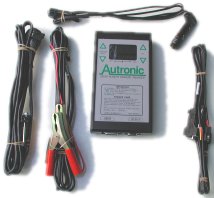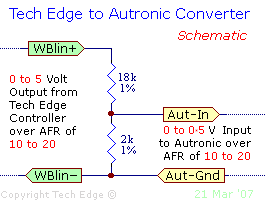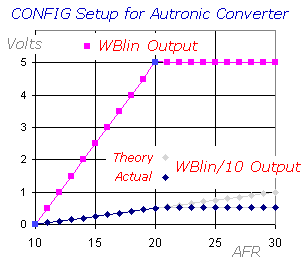Many people ask us if our controllers work with Autronic ECUs, and in particular if the Autotune function can be made to work. The simple answer is yes (see below) but certain things should be done to maximise accuracy.
But first, lets dispell some myths that seem to have accumulated. There are two Autronic Lambda meters, and they are described on the Beninca website. In the following extracts, we have added the blue italics.
- A Model: Uses a Bosch four wire broad band sensor (LSM-11) and has a air fuel ratio range of 9.0:1 to 36.0:1.
Update speed of readings is 0.5 of a second.
- B Model: Will use the Bosch sensor or a (NTK) UEGO 6 wire high speed sensor (5 wire sensor + calibration resistor wire) The high speed sensor will update every 0.10 of a second.

They also claim, of the UEGO sensor, that "it is also more accurate than the Bosch sensor". The LSM-11 is not a wideband sensor, but a narrowband (NB) sensor with tighter tolerances than a normal NB sensor. Of course the NTK UEGO will be more accurate. The Bosch LSU 5-wire (pump cell) sensor will also be more accurate than the Bosch LSM-11. Perhaps Autronic's Bosch 4-wire and NTK UEGO sensor comparison is why people familiar with Autronic think the Bosch LSU is less accurate than the NTK UEGO. They are simply confusing the Bosch LSM-11 with the Bosch LSU sensors. The fact is, comparing 5-wire sensors, the Bosch LSU is as good or better than the NTK UEGO. As the Bosch LSU is usually considerably cheaper than the NTK UEGO, the comparison is even more favourable towards the Bosch LSU. Because of the price difference - most people, it seems, buy the expensive Autronic Lambda meter but then use the narrowband LSM-11 sensor. This is total craziness! An expensive meter and an under performing 4-wire narrowband sensor. |
Issues in Using the 1 Volt Autronic Input
OK, you have a Tech Edge wideband controller with a differential 0-5 Volt output(*1).
How best to connect it to your Autronic ECU to use their Autotune function?
There are some issues to address, and we have solutions too:
0→5 Volt & 10→20 AFR ⇒ 10:1 Resistive Divider
The best way to connect your Tech Edge unit to an Autronic ECU is with a 10:1 resistive divider. We suggest you use 1% resistors of value 2k and 18k wired as shown at right. Note that there are 4 connection points:
As well as the connection points two other things must be done to the Tech Edge controller
|
Buy the pre-made 5 Volt to 1 Volt Adaptor
Although it's easy to make your own, we offer this pre-made adapter. It has over 30cm (12") of cwire between the wideband unit and the Autronic unit. There are four connection points just like the schematic shown above, and the image at right, the two BLACK wires are GND, the GREEN wire comes from the 0-5 Volt wideband output, and the ORANGE wire goes to the Autronic 1 Volt input. The shipped adapter comes covered in heat-shrink, so nothing shorts out. (*) Notes*1. The Tech Edge models 2A0 and 2A1 do not have a differential output. Other models do. |
